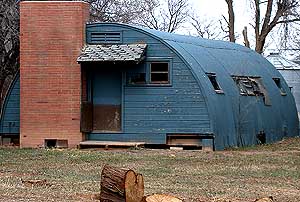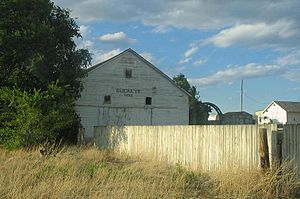Buckeye, Colorado facts for kids

Buckeye is a small farming and ranching community in northern Larimer County, Colorado, United States. It's not a city or town with its own government, but a collection of homes and farms. The area is bordered by a large ranch to the west. To the north, you'll find the Red Mountain Open Space, a natural area. To the east are the Rawhide flats, and to the south, the Owl Canyon.
The tallest building in Buckeye is a grain silo on County Road 78. You can see big feed yards behind it. These yards were once used to feed many sheep.
Contents
Buckeye's History
How Buckeye Got Its Name
In 1910, a company from Ohio called the Buckeye Land and Development Co. came to Colorado. They gave the area its name. The Buckeye Ranch was very large, covering many square miles. You can still see Buckeye trees in front of its old main building. These trees are not common in Colorado. Long ago, in the 1800s, a stop for the Overland Trail stagecoach line was located here. Its buildings later became part of the Buckeye Ranch.
The Old Railroad Line
In 1924, a train line was built from Buckeye to Fort Collins. It was used to ship sheep and other farm animals to big stockyards in Denver. In the early 1900s, Buckeye also had a gas station and a school. The train line was closed in 1965. The tracks, a bunkhouse for workers, and animal pens were all taken down. The old train station was moved south and is now a house.
The Buckeye Schoolhouse
The Buckeye School opened in 1926 for students up to 8th grade. There was a stable at the school for students who rode horses to class. The two teachers lived in an apartment in the school's basement. This was unusual, as teachers in rural areas often lived with local families.
In 1960, the Buckeye School closed. Students then rode buses about 12 miles (19 km) south to the Waverly School. After it closed, the school district let the community use the building if they kept it in good shape. In 1967, 26 local families and the 4-H Buckeye Buck-N-Ears Club bought the property. They renamed it the Buckeye Community Club. In 2008, the Buckeye School was added to the National Register of Historic Places. This means it's an important historical site.
Helping Hands: The Civilian Conservation Corps
The Civilian Conservation Corps (CCC) set up a camp in Buckeye in 1935. This program helped young men aged 17 to 23 find work during the Great Depression. They learned skills and took classes. The camp was active until 1940. The main goal was to help with soil conservation and stop erosion in the Buckeye area. The young men planted 240,000 trees! The camp was also near a source of alabaster, a soft stone. The men used it to make household items and decorations.
Water for Farms
The North Poudre Irrigation Company provides water for local farms. They get this water from the Park Creek Reservoir, which is located on County Road 80.
Ranching and Protecting Land
Early Ranchers and the Homestead Act
After the Homestead Act was passed in 1862, people could claim land to farm. Martin Calloway was one of the first settlers in Buckeye. He improved his land and was the first to use water from Boxelder Creek for irrigation. He cut hay and hauled it by oxen to Cheyenne, about 35 miles (56 km) away. There, he traded the hay for things his family needed. By the 1870s, his ranch was doing well, especially after he added sheep. The ranch was sold to the Greenacre brothers in 1909.
Big Ranches and Open Spaces
In 1917, Ida and Clarence Munroe bought the land from the Greenacres. Their ranch grew to about 8,500 acres (34 km²) by 1914. New government permits allowed ranchers to move their cattle to graze in the mountains during summer. They would bring them back to the plains for winter. By 1921, the Munroes had 3,200 sheep. They used their profits to buy other smaller ranches. Land could be bought for as little as $2.50 an acre. By the 1940s, the Munroe ranch was 20,000 acres (81 km²). In 1960, their son Edward Munroe drove the last herd of sheep from their summer grazing lands.
The Munroe ranch later became known as the Red Mountain Ranch. In 2004, Larimer County bought 15,500 acres (63 km²) of the ranch. This land became an open space for the public to visit from March to December.
To the west of Buckeye is the Roberts Ranch, started in 1874 under the Homestead Act. This ranch is 16,500 acres (67 km²) and is protected by special agreements called conservation easements. This means the land cannot be developed. The Roberts family has owned this ranch since it was first granted. They still raise cattle there today. These conservation easements help protect important historical sites and natural areas.
Protecting Land for the Future
By 2006, other ranchers in the area had also protected about 1,000 acres (4 km²) of their land from development. They worked with the Larimer County Open Lands program and the Legacy Land trust to keep these areas natural.
Images for kids
-
A Quonset hut farm home in Buckeye.




